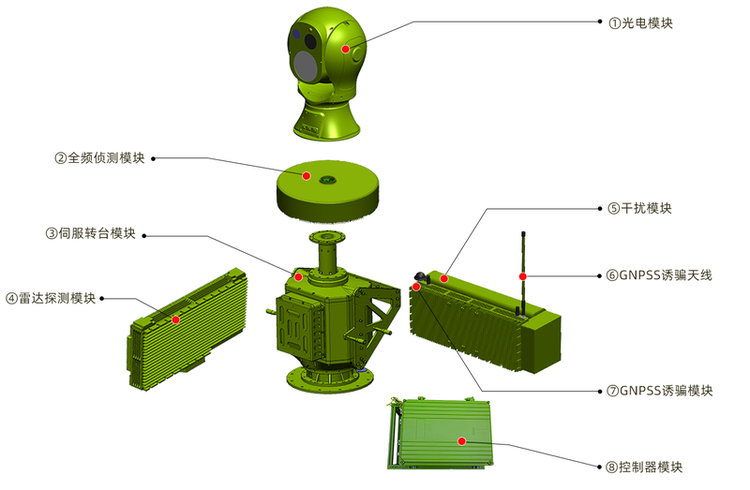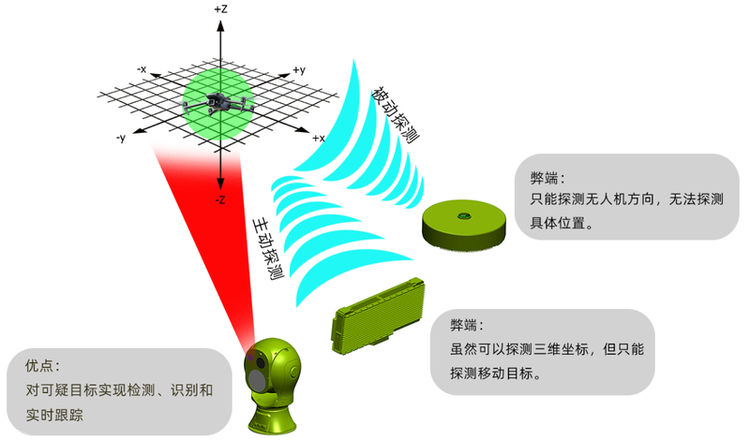Non-Kinetic Counter-Unmanned Aerial Systems: Critical Defense Technology in Maritime Warfare
With the rapid advancement of drone technology and its widespread application in the military sector, how to effectively counter drone threats has become a core issue for defense and security institutions worldwide. Non-kinetic Counter-Unmanned Aerial Systems (C-UAS), known for their high efficiency and low-risk characteristics, have gradually emerged as indispensable key technologies in modern maritime warfare. This article begins with the basic concept of non-kinetic C-UAS, providing an in-depth analysis of its working principles, challenges in maritime applications, technical advantages, and future development trends.
What Are Non-Kinetic Counter-Unmanned Aerial Systems?
Non-kinetic C-UAS refer to technological systems that disrupt, control, or even take over enemy drones through non-physical means, rather than directly destroying the target. Unlike traditional kinetic weapons, these systems primarily rely on electromagnetic waves, acoustic waves, or network signals to carry out interference, preventing unauthorized drones from entering sensitive areas or, when necessary, executing capture or forced landing operations. Since they do not rely on explosives or physical ammunition, non-kinetic systems significantly reduce collateral damage and minimize negative impacts on the environment and personnel.

Working Principles of Non-Kinetic C-UAS
a) Radio Frequency (RF) Jamming Technology
Radio frequency jamming is one of the most widely used non-kinetic counter-drone technologies. This system emits high-intensity radio waves to disrupt the communication link between the drone and its operator. Once communication is interrupted, the drone loses control commands and cannot continue its mission. Some advanced RF jamming devices can even identify signals from specific drone models, enabling precise interference.

b) Directed Energy Weapons
Directed energy weapons mainly include lasers, microwaves, and high-power ultrasonic waves. For example, laser weapons can precisely target a drone’s sensors or electronic components, rendering them ineffective; microwave weapons generate strong electromagnetic pulses, causing short circuits in the drone’s circuitry; ultrasonic technology can interfere with its navigation system, causing the target to deviate from its intended course.
c) Cyber Intrusion and Hacking Techniques
Cyber intrusion techniques involve infiltrating a drone’s control system to achieve remote takeover of the target. This method can guide the drone to land in a safe area or activate its self-destruct sequence, making it particularly effective against drones used in terrorist attacks or malicious operations.
Challenges in the Maritime Warfare Environment
The maritime warfare environment is complex and ever-changing, with ships often facing multiple threats from both the air and underwater. Particularly for small and medium-sized vessels with limited air defense capabilities, high-speed, low-altitude drones pose significant challenges. Additionally, the vastness of the sea and the mobility of targets make it difficult for traditional air defense systems to achieve comprehensive coverage. Therefore, non-kinetic C-UAS suitable for maritime environments are especially important.
Technical Advantages of Non-Kinetic C-UAS
Compared to traditional kinetic weapons, non-kinetic C-UAS offer the following significant advantages:
- Precise Control Capability: Can target specific drones for disruption or capture, avoiding collateral damage;
- Low Collateral Damage: Prevents unintended harm caused by explosives, protecting civilians and the environment;
- High Cost-Effectiveness: Easy to maintain, with lower deployment and operational costs;
- Strong Legal Compatibility: Complies with international legal frameworks and is suitable for various conflict and dispute scenarios.
Current Technological Level and Practical Applications
Several mature non-kinetic C-UAS products are already available on the market, such as Raytheon’s “Eagle Eye” system and Wuhan Lakeda’s “Hai Dong Qing” anti-drone system. These systems typically employ multi-layered defense strategies, integrating detection, identification, tracking, and jamming functions. They have successfully intercepted drone swarms in complex environments, demonstrating strong performance in real-world operations.
Future Development Trends
Looking ahead, the development of non-kinetic C-UAS will exhibit the following trends:
- System Integration: Enhanced integration with sensor networks such as satellite communications and control link interception, improving system intelligence and automation levels;
- Diverse Adaptability: Utilizing technologies like software-defined radio to enhance the ability to counter drones of various types and sizes;
- Remote Control and Autonomous Decision-Making: Developing remote control capabilities and autonomous decision-making algorithms tailored to maritime warfare needs, improving response speed and operational effectiveness;
- Strengthened Cybersecurity: As systems become more networked, enhancing resistance to hacking attacks and data encryption capabilities to ensure secure and reliable operation.
Conclusion
As an innovative defense measure, non-kinetic C-UAS will play an increasingly important role in future maritime warfare. Although challenges such as technical complexity and legal compliance remain, ongoing research and technological advancements are expected to gradually address these issues, providing strong support for global maritime security and stability.
Further Reading
U.S. Department of Defense - Counter-Small Unmanned Aircraft Systems Strategy
Official strategy document released by the U.S. Department of Defense on countering small unmanned aircraft systems, covering technological roadmaps and multi-domain applications. Ideal for gaining an in-depth understanding of policy context.U.S. Naval Institute - Naval Counter-Drone Technology Report
Authoritative naval research platform providing technical analysis and real-world deployment cases of shipboard electronic warfare, directed energy weapons, and RF jamming systems.Raytheon Technologies Official Solutions Page
Official page by Raytheon introducing its counter-drone systems, including electronic warfare, cyber takeover, and directed energy weapons, with technical details and application validations in maritime defense.Defense Advanced Research Projects Agency (DARPA) - Counter-Drone Projects
Research institution under the U.S. Department of Defense, publicly sharing progress on cutting-edge counter-drone technologies and tactical innovation solutions.